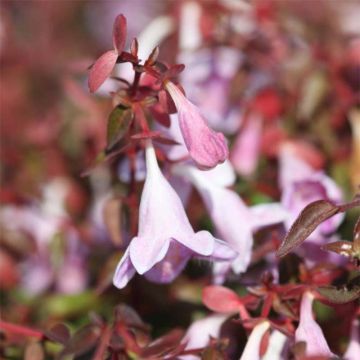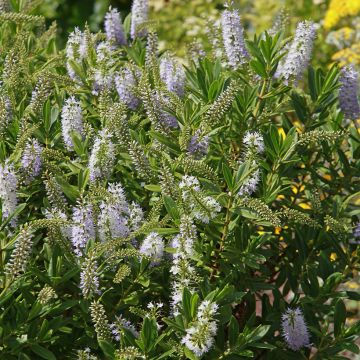

Hydrangea serrata Euphoria Pink


Hydrangea serrata Euphoria Pink


Hydrangea serrata Euphoria Pink


Hydrangea serrata Euphoria Pink


Hydrangea serrata Euphoria Pink


Hydrangea serrata Euphoria Pink


Hydrangea serrata Euphoria Pink
Hydrangea serrata Euphoria Pink
Hydrangea serrata Euphoria Pink
I was a bit worried about this color mix. But I have to admit, this plant is absolutely stunning in reality!!! Highly recommend!
SHINRA TENSEI, 05/06/2025
Special offer!
Receive a €20 voucher for any order over €90 (excluding delivery costs, credit notes, and plastic-free options)!
1- Add your favorite plants to your cart.
2- Once you have reached €90, confirm your order (you can even choose the delivery date!).
3- As soon as your order is shipped, you will receive an email containing your voucher code, valid for 3 months (90 days).
Your voucher is unique and can only be used once, for any order with a minimum value of €20, excluding delivery costs.
Can be combined with other current offers, non-divisible and non-refundable.
Home or relay delivery (depending on size and destination)
Schedule delivery date,
and select date in basket
This plant carries a 24 months recovery warranty
More information
We guarantee the quality of our plants for a full growing cycle, and will replace at our expense any plant that fails to recover under normal climatic and planting conditions.

Would this plant suit my garden?
Set up your Plantfit profile →
Description
Hydrangea serrata 'Euphoria Pink' is an exceptional variety of Hydrangea with beautiful tricoloured foliage, variegated with green, creamy white, and pink. The flowering bush is extraordinarily colourful: depending on the soil, its flowers are bright red with a white-pink centre or bluish-violet with a white centre. With moderate growth, this Hydrangea is suitable for gardens of all sizes and adapts perfectly to container gardening. A vibrant Hydrangea!
The 'Euphoria Pink' Hydrangea (synonym 'Gotemba Nishiki') is a Japanese cultivar selected by Nagasaki T. / Osco Garden. It is a quite revolutionary plant that came second in the RHS Chelsea Flower Show 2023 Plant of the Year competition. This cultivar forms a bush that reaches approximately 1 m in height with a spread of 60 cm at maturity. It forms a beautiful branching clump. Its young leaves are tinged with pink. As they unfurl, they are initially variegated with creamy white and pale pink on a green background, with the pink fading as temperatures rise. This exuberant, deciduous foliage is ornamental from spring to autumn, even outside of the flowering period. Flowering begins around mid-June, depending on the climate, and lasts until August, on the current year's wood. The flowers are grouped in slightly rounded, airy heads. Each of these inflorescences is composed of a few rare tiny florets scattered among numerous larger and very colourful fertile florets. The colour of the flowers varies depending on the soil's pH and the presence or absence of aluminium sulfate. Red will appear in neutral soil, while bluish-violet will appear in acidic soil.
Hardy down to -20°C, the 'Euphoria Pink' Hydrangea should be exposed to partial shade or morning sun to preserve its magnificent variegated foliage. It finds a place in a shrub border, as a standalone specimen, and of course in a large pot on the terrace. Consider using it to spice up a small flowering hedge. Pair it with other plants that prefer humus-bearing, non-calcareous soil: Pieris japonica 'Flaming Silver', Azalea 'Adonis' with white flowers, Camellia 'Fairy Blush', Fuchsia magellanica 'Versicolor'... Also, it's worth knowing that Paulownia is very beneficial to hydrangeas, as its turgid roots provide nourishment to the shrubs growing beneath.
Report an error about the product description
Hydrangea serrata Euphoria Pink in pictures




Plant habit
Flowering
Foliage
Botanical data
Hydrangea
serrata
Euphoria Pink
Hydrangeaceae
Hydrangea Gotemba Nishiki
Cultivar or hybrid
Planting and care
When planting your Hydrangea serrata 'Euphoria Pink', choose geranium potting soil over ericaceous soil for its very useful water retention power, richness in nutrients, and pH below 7. Use liquid geranium fertiliser and every three to four years, apply well-decomposed cow manure mixed with leaves to avoid attracting moles or promoting Armillaria (a fungus that destroys the roots). To promote good growth, mulch the base. Grass clippings can be used in thin layers. Water sparingly but frequently with non-limestone water. Beware of slugs from February onwards, as they attack young buds. Avoid planting your hydrangeas under a birch, hazel, or ash tree due to root competition that could hinder growth. Prune completely dry stems at the base at the end of winter, only perform partial maintenance pruning on the older stems halfway up, above new young shoots.
Planting period
Intended location
Care
-
, onOrder confirmed
Reply from on Promesse de fleurs
Similar products
Haven't found what you were looking for?
Hardiness is the lowest winter temperature a plant can endure without suffering serious damage or even dying. However, hardiness is affected by location (a sheltered area, such as a patio), protection (winter cover) and soil type (hardiness is improved by well-drained soil).

Photo Sharing Terms & Conditions
In order to encourage gardeners to interact and share their experiences, Promesse de fleurs offers various media enabling content to be uploaded onto its Site - in particular via the ‘Photo sharing’ module.
The User agrees to refrain from:
- Posting any content that is illegal, prejudicial, insulting, racist, inciteful to hatred, revisionist, contrary to public decency, that infringes on privacy or on the privacy rights of third parties, in particular the publicity rights of persons and goods, intellectual property rights, or the right to privacy.
- Submitting content on behalf of a third party;
- Impersonate the identity of a third party and/or publish any personal information about a third party;
In general, the User undertakes to refrain from any unethical behaviour.
All Content (in particular text, comments, files, images, photos, videos, creative works, etc.), which may be subject to property or intellectual property rights, image or other private rights, shall remain the property of the User, subject to the limited rights granted by the terms of the licence granted by Promesse de fleurs as stated below. Users are at liberty to publish or not to publish such Content on the Site, notably via the ‘Photo Sharing’ facility, and accept that this Content shall be made public and freely accessible, notably on the Internet.
Users further acknowledge, undertake to have ,and guarantee that they hold all necessary rights and permissions to publish such material on the Site, in particular with regard to the legislation in force pertaining to any privacy, property, intellectual property, image, or contractual rights, or rights of any other nature. By publishing such Content on the Site, Users acknowledge accepting full liability as publishers of the Content within the meaning of the law, and grant Promesse de fleurs, free of charge, an inclusive, worldwide licence for the said Content for the entire duration of its publication, including all reproduction, representation, up/downloading, displaying, performing, transmission, and storage rights.
Users also grant permission for their name to be linked to the Content and accept that this link may not always be made available.
By engaging in posting material, Users consent to their Content becoming automatically accessible on the Internet, in particular on other sites and/or blogs and/or web pages of the Promesse de fleurs site, including in particular social pages and the Promesse de fleurs catalogue.
Users may secure the removal of entrusted content free of charge by issuing a simple request via our contact form.
The flowering period indicated on our website applies to countries and regions located in USDA zone 8 (France, the United Kingdom, Ireland, the Netherlands, etc.)
It will vary according to where you live:
- In zones 9 to 10 (Italy, Spain, Greece, etc.), flowering will occur about 2 to 4 weeks earlier.
- In zones 6 to 7 (Germany, Poland, Slovenia, and lower mountainous regions), flowering will be delayed by 2 to 3 weeks.
- In zone 5 (Central Europe, Scandinavia), blooming will be delayed by 3 to 5 weeks.
In temperate climates, pruning of spring-flowering shrubs (forsythia, spireas, etc.) should be done just after flowering.
Pruning of summer-flowering shrubs (Indian Lilac, Perovskia, etc.) can be done in winter or spring.
In cold regions as well as with frost-sensitive plants, avoid pruning too early when severe frosts may still occur.
The planting period indicated on our website applies to countries and regions located in USDA zone 8 (France, United Kingdom, Ireland, Netherlands).
It will vary according to where you live:
- In Mediterranean zones (Marseille, Madrid, Milan, etc.), autumn and winter are the best planting periods.
- In continental zones (Strasbourg, Munich, Vienna, etc.), delay planting by 2 to 3 weeks in spring and bring it forward by 2 to 4 weeks in autumn.
- In mountainous regions (the Alps, Pyrenees, Carpathians, etc.), it is best to plant in late spring (May-June) or late summer (August-September).
The harvesting period indicated on our website applies to countries and regions in USDA zone 8 (France, England, Ireland, the Netherlands).
In colder areas (Scandinavia, Poland, Austria...) fruit and vegetable harvests are likely to be delayed by 3-4 weeks.
In warmer areas (Italy, Spain, Greece, etc.), harvesting will probably take place earlier, depending on weather conditions.
The sowing periods indicated on our website apply to countries and regions within USDA Zone 8 (France, UK, Ireland, Netherlands).
In colder areas (Scandinavia, Poland, Austria...), delay any outdoor sowing by 3-4 weeks, or sow under glass.
In warmer climes (Italy, Spain, Greece, etc.), bring outdoor sowing forward by a few weeks.








































